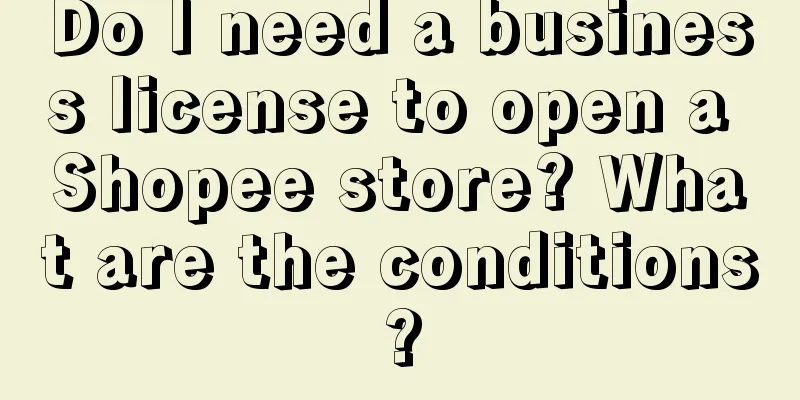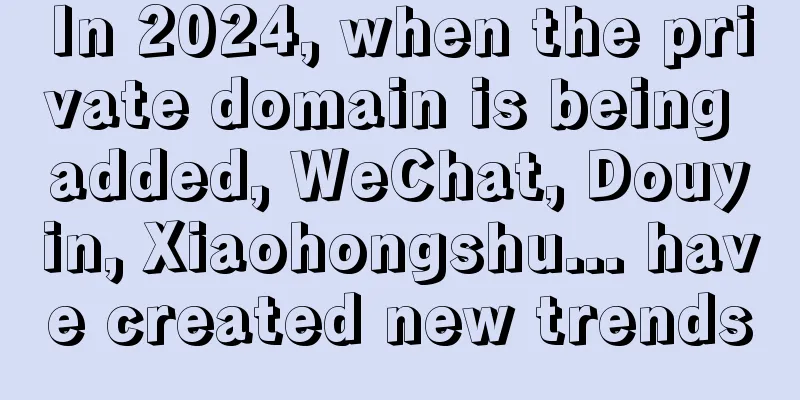How to use the “people-goods-field” model? Why is the Internet industry also discussing it?

Many data analysis books and articles have mentioned the people-goods-place model, but there is no detailed introduction to the core of how to match people and goods. People-goods matching is a very basic analysis theory, involving important issues such as conversion rate analysis, user grouping, and recommendation algorithm training. Whether it is e-commerce, O2O, short videos, live broadcasts, etc., Internet products will consider this. Without further ado, today I will introduce it in detail. 1. Shopping guide matchingImagine the simplest scenario: a customer stands in front of the counter and says "I want an electric fan". At this point, the customer has come to the store with a long journey and is very willing to make a deal. And the demand has been expressed very clearly. As a shopping guide, what you need to confirm is: what kind of electric fan it is. This is the common: shopping guide matching. At this time, the matching is mainly based on specific product information, such as: Scene: For going out? For desk? For bedroom? For living room? Style: handheld, tabletop, floor-standing? Price: Is the price roughly within the range of XXX? Design: Are you satisfied with the appearance/color/shape? Note that the matching of these four pieces of information is a progressive relationship. The usage scenario determines the style, price, and design. The price in turn determines the design, workmanship, and other details. Therefore, an excellent shopping guide must confirm from the big to the small, so that it is easier to lock in customer needs and increase the matching success rate. That’s why we call them shopping guides (like a guide guiding purchases) instead of salesmen. Brainless salesmen will start talking a lot right away: “Our products have 18 functions, 20 patents, and all kinds of awesomeness…” Of course, for different products, the shopping guides use different methods to improve the matching success rate. Common methods include: 1. Scenario matching: Common in durable goods and large items. Starting from the demand scenario, it gradually guides to specific price and function. 2. Experience matching: Common in fast-moving consumer goods, clothing, and beauty industries. Let users experience the product directly, and if the experience is good, the demand will be locked in immediately. 3. Display matching: Common in fast-moving consumer goods, especially small-amount instant consumption products such as beer, melon seeds and mineral water. Customers buy them just for the sake of novelty, so they just display dozens of products and take whichever one they like. 4. Price matching: Common in fast-moving consumer goods, especially daily necessities, household, care, and cleaning products. These chemical products have low costs, long stocking cycles, are needed daily, and users are price-sensitive. As long as the price is discounted, they can attract a wave of stockpiling. So in theory, scenario matching is the best shopping guide matching model. But in reality, for many fast-moving consumer goods, consumers do not have the patience to think carefully about why they buy them. Consumers themselves are impulsive consumers. Therefore, there is no need to match scenarios for everything. Experience, display, and price are all very useful. Only large items are suitable for carefully combing scenarios and guiding. Summarizing the above factors, we can derive the analysis model of shopping guide matching (as follows): 2. Store Type MatchingImagine a slightly more complicated scenario: a customer is walking in a shopping mall and has not yet decided which store to go to. At this point, the customer is not very willing to make a deal (even unsure if he is here to shop), and his needs are not clear. Therefore, it is impossible to accurately match a product right away. The matching that needs to be done at this time is essentially: picking out users with needs and guiding them to the store. Note: In this scenario, it is impossible to obtain accurate user information. When customers are still wandering around the mall, asking a bunch of questions is not only long-winded, but also scares customers away. At this time, what is more needed is a means of attracting customers with needs, while trying to avoid customers without needs to avoid wasting resources. Commonly used methods include: 1. Based on natural cycles: Most consumer goods can be used, because most consumer goods have their own fixed hot-selling time periods in a year, such as weekends, the end of the month, the end of the quarter, and during festivals. You can carry out activities in the corresponding time periods. 2. Based on the consumption cycle: According to the customer's consumption record, the previous purchase is estimated to have been consumed, and a reminder is given for a second purchase. 3. Based on user stratification: Common in industries with large customer concentration, such as beauty and health. Targeted invitations and activities are carried out for high-end users, which can prevent customer loss on the one hand, and set an example for potential large customers on the other hand to attract them to join. 4. Life cycle-based: Common in industries with strong life cycles such as maternal and child care, education, and health. If you want to intercept mothers, babies, and the elderly, just go to the park, amusement park, or ball pool and bring toys, eggs, rice, flour, oil, etc. 5. Channel-based: Common in industries that require large customers, such as finance, real estate, and home furnishing. Focus on promoting in channels where target customers gather (enterprises, communities, chambers of commerce, etc.) to attract customers. Since neither the customer's purchase intention nor the demand is certain, the matching success rate at this stage is bound to be greatly reduced. In addition, there are too many influencing factors, and it is impossible to analyze clearly: which link caused the failure of the transaction. Therefore, in order to improve the efficiency of analysis, it is generally divided into two stages for analysis: attracting traffic to the store and closing the deal in the store. Separately assess the quality of various means of attracting traffic to the store, and then guide the transaction after seeing the store. Summarizing the above factors, we can derive the analysis model of store type matching (as follows): 3. Shopping mall type matchingImagine a more complex scenario: a customer is walking in a pedestrian street and has not yet decided which mall to go to. At this point, the customer's willingness and demand for a transaction are very unclear, or they may just be passing by. Note: In this scenario, the mall and the store are thinking about different issues. Store: If there is no traffic in the mall, close the store and find a store in a mall with traffic. Shopping mall: I don’t care about the life or death of a specific store. As long as I have traffic, there will be a steady stream of people opening stores. This divergence of interests directly led to differences in subsequent analysis ideas. Only shopping malls care about how to match pedestrian street users to them. The matching logic of products is very simple and crude: 1. Monopoly: I use ultra-low price subsidies to kill my competitors, or I directly occupy the main road of the pedestrian street! Users will naturally come to me. 2. Attract partners: I will attract some big brand stores to move in at low prices, which will naturally attract high-end users. 3. Generate traffic: I open a cheap giant supermarket on the underground floor, and customers will naturally flock to buy. 4. Provide supporting facilities: I will open a large children's playground, and parents will bring their children to play and go shopping at the same time. A careful observation will reveal that: user needs are hardly considered here. It is purely a business operation. In fact, shopping malls also need to consider user needs. After all, the above four points can only attract users. If you want to make more money, you have to attract small businesses to move in. Therefore, it involves the question of how to match users to small businesses. The mall does not care about the life or death of a small business (unless it is their own son). Therefore, the mall handles the problem of matching users with businesses in a very simple and crude way: 1. Buy directly. I will sell to whoever pays for a good shop. 2. Allocate businesses by region. If a movie theater is located, place milk tea and snacks next to it. 3. Observe user behavior. For example, mothers like to look at maternal and child products while taking their kids out for a stroll in the bouncing pool, so we can promote the parent-child consumption season. That’s enough. Then you can package some success stories and show them to small businesses that haven’t settled in yet: “Look how much money you can make by settling in here, come quickly.” 4. Traditional Enterprises VS Internet EnterprisesSome students may say: Teacher Chen, you are talking about traditional shopping malls, but we are in the Internet industry. In fact, after carefully looking at these three matching models, what did you find? The so-called Internet is simply moving traditional shopping malls online! Replacing shopping guides with influencers is the so-called live e-commerce gameplay Replacing the shopping guide with adding personal WeChat is the so-called private domain traffic gameplay Replacing the store’s advertisements in shopping malls with direct traffic is the way platform e-commerce plays Replacing the roadside advertisements with WeChat groups is a social marketing method. Replacing the store VIP gift for bringing in new customers with fission advertising is the way to play fission growth Replace the mall with XX platform. These Internet APPs burn money, distribute coupons, and buy for 1 yuan. Are they familiar? Instead of dividing merchants by region, the distance function between products is calculated based on the attributes of the first clicked product, which is the similarity recommendation algorithm in the recommendation algorithm. Instead of promoting activities based on group behavior, we divide groups of people into groups based on similar click behaviors and then recommend products. This is the collaborative filtering algorithm. Therefore, the so-called e-commerce is still business, and the operating logic is essentially the same. The difference is that user behavior on the Internet can leave sufficient data records, so relatively accurate analysis can be carried out. It is no longer necessary to rely on researchers to observe consumer movement lines on site with their naked eyes like in traditional stores. This also reflects from another perspective: Don’t be superstitious about the so-called "big manufacturer recommendation model". The ideas and key elements of recommending products for different roles and scenarios are completely different. Blindly copying will only be superfluous. |
<<: Preparations for Double 11 are advanced, and e-commerce bids farewell to the "ROI-only theory"
>>: Revealed for the first time: What did Duolingo do to trap 500 million people?
Recommend
Playing the Olympic card, Xiaohongshu can hardly realize its dream of becoming an "encyclopedia of life"
Xiaohongshu, as a platform with content sharing at...
What does the popularity of "Black Plum Sauce" reflect?
I believe everyone has been brainwashed by the son...
How to improve business understanding if there is no opportunity to get in touch with the business?
How can you improve your business understanding be...
How to use Amazon advertising discount coupons? Instructions for use
For some suppliers and sellers who are eligible to...
Does Amazon drop shipping require FBA? How to do it?
Many merchants on Amazon do not have their own sou...
Recruiting "Internet celebrities" and creating IP, is JD.com's ambition for live streaming no longer hidden?
JD.com is recruiting influencers through live stre...
With a monthly income of 5 million, the "earthy" Internet celebrity makes money openly
Tuwei Internet celebrities, with their unique imag...
3,300 stores opened in 10 years, how can the fresh food industry do a good job in private domain? An article dismantles Qiandama’s private domain system
At present, Qiandama has set up stores in more tha...
Secretive and drastic, the traffic changes of Douyin and Xiaohongshu and how to deal with them
The author of this article shares an in-depth meth...
Do Amazon sellers need to pay taxes in the country? What taxes do they need to pay?
Many merchants like to open stores on Amazon. Afte...
How to list products on Shopee's second site? What are the tips?
On the Shopee platform, seller friends can also op...
How to fill in Shopee username? What are the filling tips?
Dear friends, if you want to shop on the Shopee cr...
We discussed these 6 issues regarding the future development trend of Xiaohongshu
This article analyzes and explains the future deve...
7 tips for amateurs to create an account on Xiaohongshu, and tips for creating an account with a single article
If you are a newly created blogger on Xiaohongshu,...
Meituan-Kuaishou cooperation upgraded to "100 cities, 10,000 stores"
The cooperation upgrade between Kuaishou and Meitu...









